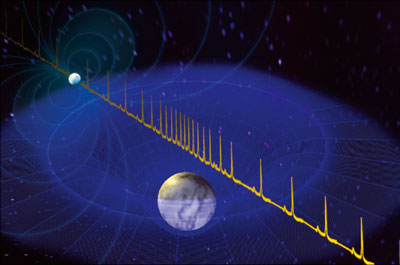
Image credit: Bill Saxton, NRAO/AUI/NSF.
The most precise determination yet of the mass of a heavy neutron star in a binary system has important implications on its matter content. With a mass twice that of the Sun, the millisecond-pulsar J1614-2230 rules out almost all currently proposed compositions based on hyperon or boson condensates, as well as weakly interacting quarks.
Neutron stars are the densest bodies in the universe. Their density of about 100,000 tonnes per cubic millimetre is comparable to that of atomic nuclei. They form at the heart of massive stars by the collapse of the iron core when nuclear fuel is exhausted. Their formation triggers the explosion of the outer parts of the star that is witnessed as a supernova event (CERN Courier November 2008 p11). Pulsars are neutron stars that emit regular pulses of radiation. These “lighthouses of the Milky Way” send a beam of radiation along the direction of their strong magnetic field, which rotates as the neutron star spins.
While the spin period of typical pulsars is around a second, a subclass of them exhibit pulsations on periods down to milliseconds. Such rapidly spinning neutron stars are thought to have been “spun-up” via accretion of matter from a companion star. Their rapid pulses are precise chronometers and allow astronomers to derive the orbital period of the binary star system. What makes the millisecond-pulsar J1614-2230 special is that the companion star is a white dwarf and the orbital motion of the system is seen almost perfectly edge-on from Earth. Like neutron stars, white dwarfs are remains of stellar evolution, but with a much lower density (CERN Courier October 2009 p10). Their gravitational potential well is, however, deep enough to make a significant imprint on space–time. Hence, the radio pulses from the pulsar passing by the white dwarf on their journey to the Earth will be delayed.
It is this effect of general relativity, identified by Irwin Shapiro in 1964, that was precisely measured to determine the mass of the neutron star in J1614-2230. Paul Demorest of the National Radio Astronomy Observatory (NRAO) in Virginia and colleagues from the US and the Netherlands performed a dense set of radio observations of the system in March 2010 with the NRAO Green Bank Telescope. The data were taken with a new instrument, which corrects interstellar dispersion smearing, and covered the 8.7-day orbital period of the system. These high-accuracy measurements were combined with previous long-term data to characterize the binary system in full. The “Shapiro delay” was detected with extremely high significance, a Markov-chain Monte Carlo approach being used to estimate the errors in the parameters. The derived masses for the white dwarf and the neutron star are 0.500 ± 0.006 and 1.97 ± 0.04 solar masses, respectively. This is by far the most precisely measured neutron star mass to date and allows constraints on the equation of state (EOS) of their nuclear matter.
Only a subset of all proposed EOSs are consistent with such a high mass and those are mainly the ones with standard nuclear matter. Most “exotic” hadronic models are too soft at the core of the star to sustain such a high mass. This is particularly the case for hyperons or kaon condensates. Demorest and colleagues note further that condensed quark matter at the heart of the neutron star is not ruled out, but the quarks have to be strongly interacting and are therefore not “free” quarks. This seems to indicate that neutron stars are indeed mainly composed of neutrons, although James Lattimer of the State University of New York at Stony Brook notes that depending on the radius of the star, exotic models could still be viable solutions.
The origin of this unusually heavy neutron star is another mystery. Was it so heavy when it was formed during the supernova explosion, or did it grow through efficient matter transfer from the companion star, or both?





